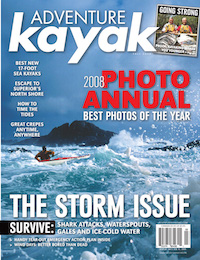The top nine survival tips for ocean sea kayaking expeditions, according to expert instructor John Wilde, include staying fit and always having a plan B. John “Wildey” Wilde started paddling on the open sea as a teenager, growing up on England’s exposed northwest coast in the mid-1960s. For the next two and a half decades, he paddled rivers, and competing in slalom canoe on the British and Australian national teams. He’s also taken part in more than a dozen Himalayan paddling expeditions, including leading the first descent of Nepal’s Sun Kosi River.
These days, John spends more of his time sea kayaking, putting his rough water skills to use along the big-surf coasts of eastern Australia. He is also the highest-qualified sea kayaking instructor in Australia. John recently undertook a solo paddle down Tasmania’s rugged east coast, notorious for its foul weather conditions, and survived paddling against 60-knot winds and a love bite from a giant shark. Here, John shares the extra preparations that he credits with saving his life.
Stay fit
“When an un-forecast 60-knot offshore wind came up towards the end of a 60-kilometre day, I was faced with a huge struggle to get back to shore—or the next stop would be New Zealand!” John says that if it were not for his strength and conditioning, he would not have made it. “For me, my fitness routine means paddling several times a week—if nothing else on the local lake, as well as rollerblading, some gym work, cross-country skiing in season and, of late (and to combat old age), yoga for flexibility.”
Have a bombproof (and toothproof) boat
When paddling in deep water offshore, John felt a sudden bump as his kayak lifted out of the water. Heart pounding, he sprinted to shore, to find big grooves in the gel coat and compression cracks in the hull just forward of the seat—and two glistening white shark’s teeth embedded just centimetres from where his thigh had been!
John’s usual sea kayak is a lightweight graphite-Kevlar layup. “It is close to 10 years old and I love it, but it is light and easily damaged. My main thoughts were about dragging it up remote beaches fully loaded on my own, or landing in big surf.” So he switched to a heavier, more robust boat, which ended up not only saving the boat from damage, but protecting John himself.
Paddle hard and carry a predictable stick
For the last four years, John had been has been paddling mostly with a wing paddle, which is much more efficient for a forward stroke. “But it is hard to brace with, and generally more unstable to use. So I went back to a standard, spooned blade, more stable for bracing into a breaking wave and generally more predictable to use when the going gets tough.”
Supersize your rudder
If you use a stern-mounted rudder, chances are that in big seas, it spends most if its time out of the water. A handy friend of John’s made him a new rudder, six centimeters longer than the standard. “This bites much better in a following sea, so I have more control, especially when I am under sail.”
Practice, practice, practice
“I spend a lot of time surf kayaking. This involves lots of rolling, a really basic skill in surf, as well as bracing, balancing and judging waves. All these are essential to serious expedition paddling.”
Know where you are
Practice navigation skills too; don’t rely on a GPS. John says that expedition paddlers should try to work with charts and maps fairly regularly.
Test your gear in real-world conditions
Like many Australian paddlers, John frequently uses a kayak sail on the open sea. When testing the sail he intended to take on the trip in gusting 30-knot winds, he suddenly found himself upside-down. And to make things worse, with the weight of the mast and a sail dragging in the water, he was unable to roll up. From this gear test, he chose to completely revamp his system, purchasing a new, smaller sail that is more manageable in high winds along with a much shorter mast.
Have a plan B
John says, “Finally I bought a top-of-the-line paddle float, something I have never used before as my roll is usually strong. I had it strapped to the back deck the whole time. It’s always handy to have an insurance policy!”
Do your rescuers a favour
“If something goes wrong, someone is going to spend a lot of time looking for you.” John feels that you owe it to rescuers to be able to make contact, so he carries a phone secured in a waterproof pack, as well as a VHF radio, PLB (personal locator beacon), and flares stashed in the pocket of his PFD—accessible in case he ever ends up swimming.




